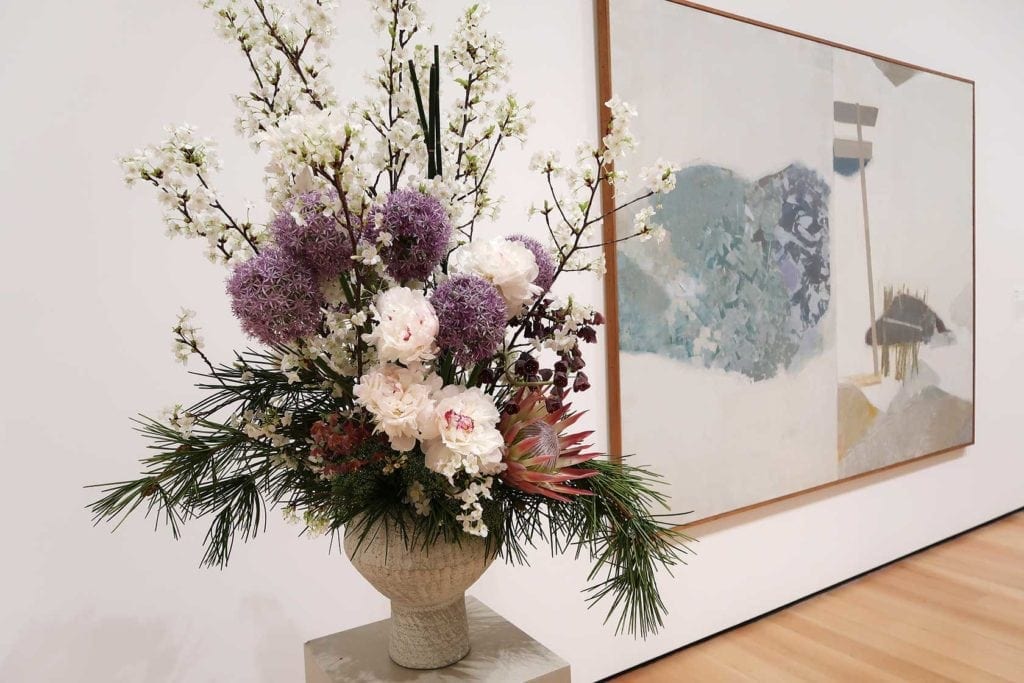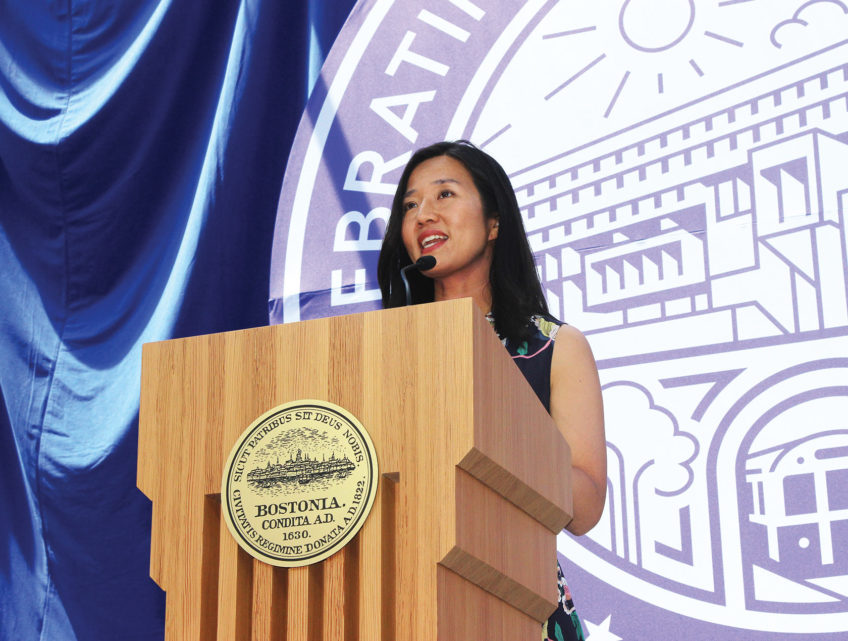
Spring was a tease last weekend, with a sublime Saturday and downpours before and after. A more reliable celebration of spring was indoors, at the Museum of Fine Arts Boston, where the museum’s 42nd annual “Art in Bloom” brought floral magic to works of art throughout the museum from April 28 to April 30.
Each year in late April, “Art in Bloom” takes over the entire museum, drawing thousands of visitors to enjoy floral arrangements devised by more than 50 New England garden clubs. Months in advance, the clubs select works of art and design floral arrangements to highlight their chosen subject — a piece of furniture, a sculpture, a painting, even a costume.

“La Baker” (1977), Loïs Mailou Jones, with floral arrangement by the Osterville Garden Club. Photo: Susan Saccoccia
The event began on Friday evening with a members’ preview and continued through Monday with activities that included classes and lectures by guest floral design experts, guided tours, and family-friendly artmaking activities and musical performances.
Among the garden club installations were traditional arrangements that combine artifice with nature, incorporating dry elements such as bamboo, synthetic materials and wooden inserts into formal works that are much admired by garden club cognoscenti.
Some clubs create fresh, living floral arrangements that bring a light and vivid sense of the season to their chosen works, drawing a viewer’s attention both to the bouquet and the art object, and inviting viewers to experience the art in a new way.
Two such pairings were in the MFA’s contemporary art galleries, where an exhibition entitled “Seeking Stillness” presents a collection of works conducive to contemplation.
A gleaming tower of chrome-plated stainless steel by Chinese artist Zhan Wang, “Artificial Rock #85” (2005) is a somewhat ironic take on a traditional Chinese scholar’s rock, a home-size meditative object that evokes the distorted formations in a mountain cliff. The Community Garden Club of Duxbury echoed the sculpture’s scale and grandeur in a delicate arrangement composed of flowers that a monk might find on a mountain path. Moss-covered branches extended its height, and sprigs of small buds translated the sculpture’s bulk into an airy equivalent.
Pastel hues
Evoking the soft hues and hints of natural forms in the lyrical abstract painting “A Story” (1966), by Japanese-American artist Kenzo Okada, was a bouquet by the Chestnut Hill Garden Club. Spikes of pine reflected the linear shapes in Okada’s painting while framing the pastel flowers.

“Artificial Rock #85” (2005), Zhan Wang, with floral arrangement by the Community Garden Club of Duxbury. Photo: Susan Saccoccia
Another pair of captivating flower-and-painting duets was in the Art of the Americas wing. In the Saundra B. and William H. Lane Galleries, Georgia O’Keeffe’s “Fishhook from Hawaii No. 2” (1939) is a serene semi-abstract painting inspired by the New Mexican artist’s visit to Hawaii. The Weymouth Garden Club accompanied the painting with an arrangement of delphinium, ginger, orchids and other flowers. Its burst of red mimicked the scarlet feather of the lure; a row of carnations repeated the pink-hued horizon that crosses the oceanic blue panel in the painting, in which the round sphere of the lure floats like a looking glass, heightening the separation of sky and sea.
Exuberant color
Dominating the John Axelrod Gallery, which features works by African-American artists, is “La Baker” (1977), by Loïs Mailou Jones. While living “shackle-free” in Paris, Boston-born Jones befriended expatriate singer and dancer Josephine Baker, who also found liberation in Paris, along with international renown. The Osterville Garden Club captured the exhilaration of the artist’s tribute to Baker with its bold patterns, sleek, minimalist dancing figures and exuberant, earth-toned palette. Bird of paradise, calla lilies, orchids, anthurium and other blossoms reflected the painting’s feast of color, and angular leaves echoed the strong lines in its African motifs.
The MFA’s celebration of spring extends outdoors, in its contemplative Japanese rock garden, Tenshin-En (Garden of the Heart of Heaven), where flowering dogwoods and cherry trees are in bloom.






